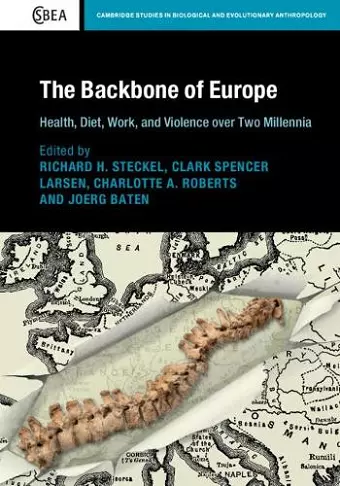The Backbone of Europe
Health, Diet, Work and Violence over Two Millennia
Charlotte A Roberts editor Clark Spencer Larsen editor Richard H Steckel editor Joerg Baten editor
Format:Hardback
Publisher:Cambridge University Press
Published:15th Nov '18
Currently unavailable, and unfortunately no date known when it will be back

Represents the largest recorded dataset based on human skeletal remains from archaeological sites across the continent of Europe.
The first of its kind collection and analysis of human health data recorded from the skeletal remains of 15,119 individuals at 101 localities across the continent of Europe. The book will interest a wide range of scholars and students across the medical and the social sciences.Using human skeletal remains, this volume traces health, workload and violence in the European population over the past 2,000 years. Health was surprisingly good for people who lived during the early Medieval Period. The Plague of Justinian of the sixth century was ultimately beneficial for health because the smaller population had relatively more resources that contributed to better living conditions. Increasing population density and inequality in the following centuries imposed an unhealthy diet - poor in protein - on the European population. With the onset of the Little Ice Age in the late Middle Ages, a further health decline ensued, which was not reversed until the nineteenth century. While some aspects of health declined, other attributes improved. During the early modern period, interpersonal violence (outside of warfare) declined possibly because stronger states and institutions were able to enforce compromise and cooperation. European health over the past two millennia was hence multifaceted in nature.
'Over the last half-century there have been only a handful of publications that have pushed the boundaries of bioarchaeology, and The Backbone of Europe is one. This is bioarchaeology at its finest. The analysis of 15,119 human remains made it possible for the authors to discern the subtle nuances of interplay between economics, social change, and health. The Backbone of Europe is the ultimate bioarchaeological synthesis.' Jerry Rose, University of Arkansas
'This is another impressive example of the rich harvest of a daring and highly innovative research strategy: to squeeze all information from the archaeological records of human skeletons. This time, Europe is the focus of attention. The large dataset and the advanced techniques lead to many new insights into the long-term development of health, stature, workload, and violence in the continent from Antiquity to the present, challenging established views that the 'rise of the West' was an almost continuous process of economic and sociopolitical development.' Jan Luiten van Zanden, Utrecht University, The Netherlands
'In this companion volume to the much-acclaimed one on the Western Hemisphere, the authors chronicle in amazing detail the longitudinal and cross-sectional patterns in the health of human populations in Europe from the beginning of time to the modern era based on the physical remains of our ancestors. The 500 pages read like an exciting detective novel with a myriad of surprises along the way, and not only about health but also about diet, lifestyle, and violence. One can trace elements of a Malthusian demographic system across the millennia, beginning with the relatively good health of the Early Medieval populations and with the usual suspects of population density, inequality, income, and climate being the contributing cyclical factors. This book is a delight to read and ponder over. The reader will appreciate the immense amount of effort that went into each one of the projects.' John Komlos, University of Munich, Germany
'… foundational … a starting point for researchers in bio-demography, anthropometrics, and economic history.' Scott Alan Carson, Journal of Economics and Political Economy
ISBN: 9781108421959
Dimensions: 252mm x 178mm x 26mm
Weight: 1100g
476 pages